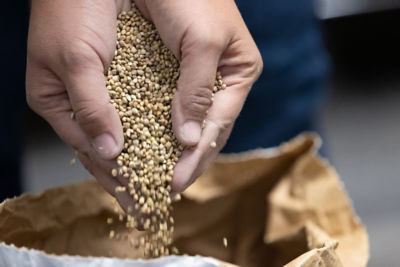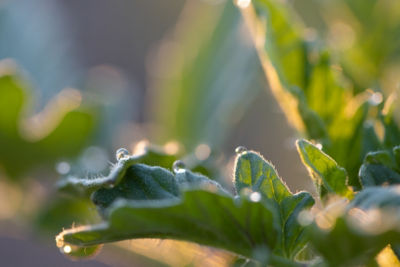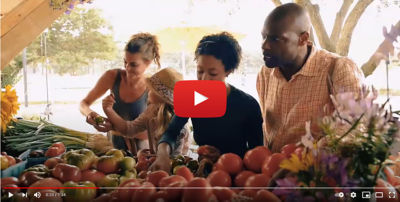Click here to download a PDF version of this spotlight.
» Seedless watermelon production requires the use of pollenizer plants as sources of pollen.
» One-third to one-quarter of the plants in a seedless planting should be seeded varieties.
» Pollenizer plants can be planted in separate rows or between the seedless variety plants within each row.
Seedless varieties of watermelon have increased in popularity over the past few years, and seedless watermelons dominate the market in many areas of the U.S. Because they have special requirements for pollination, plant spacings can differ from those used for standard, seeded varieties, and plantings must include pollenizer plants to allow for adequate pollination.
FIELD SPACINGS AND BEE REQUIREMENTS OF SEEDED VARIETIES
The spacing of standard, seeded watermelon varieties varies somewhat, depending on the varieties used and location. For varieties that produce larger fruit (18 to 21 lbs), between-row spacings range from six to nine feet, and plant-to-plant spacings within the rows range from three to eight feet. For smaller “ice- box” types, the spacing is usually somewhat closer. A five foot between-row spacing and a two foot within-row spacing is typical for these small fruit types.1
Honey bees are typically used to pollinate commercial watermelon plantings. Each female flower needs to be visited by a bee six to eight times and receive about 1,000 grains of pollen to ensure adequate fertilization and proper fruit development. Supplying an average of one active hive per acre usually provides enough active bees to meet these pollination requirements.
SEEDLESS WATERMELONS NEED POLLENIZER PLANTS
Seedless watermelon varieties produce fewer seed because genetically they are triploids, having three copies of each chromosome, rather than the two copies found in standard diploid varieties. As a result, the pollen that they produce is not viable, and these plants are not able to self pollinate. However, the female flowers still need to be fertilized by viable pollen to promote fruit set and development. For this reason, plantings of seedless watermelons have to include diploid plants to serve as sources of viable pollen for the seedless plants.2
Bees foraging in these mixed plantings pick up both viable pollen from the diploid plants and non-viable pollen from the seedless triploids. However, the female flowers on the seedless plants still need to receive 1,000 grains of viable pollen to be adequately fertilized. This requires a greater number of bee visits per flower (16 to 24) for the seedless triploids than for the diploid plants, which may necessitate a greater number of hives per acre.3
Studies have shown that one-quarter to one-third of the plants in a planting of seedless varieties need to be diploid “pollenizer” plants, and the current recommendation in most areas is a ratio of one pollenizer for every three seedless plants.4 Because the timing of pollen production and the receptiveness of female flowers to pollen can vary among varieties, care must be taken in variety selection and planting times to ensure the synchronization of these events within the planting. A pollenizer that produced pollen more quickly than the time it takes for female flowers to become receptive may require that the pollenizer be planted a week or two after the seedless variety. 3
ARRANGEMENT OF POLLENIZER PLANTS
Two basic strategies are used in the arrangement of pollenizer plants within seedless variety plantings.
One strategy is to plant dedicated rows of diploid pollenizer plants among the rows of triploid plants.2 A typical arrangement is to plant one pollenizer row for every three rows of triploid plants. In other words, every fourth row is planted to a pollenizer variety (Figure 1).
 Figure 1. Dedicated pollenizer rows are planted every fourth row to provide a 3:1 ratio of plants of seedless to pollenizer varieties.
Figure 1. Dedicated pollenizer rows are planted every fourth row to provide a 3:1 ratio of plants of seedless to pollenizer varieties.
To make sure that fruit from the seeded pollenizer plants do not get mixed up with the fruit from the seedless plants, the pollenizer rows should be harvested at a different me, and/or the fruit should be easy to distinguish from the seedless fruit by differences in fruit size or rind pattern. The downside of this arrangement is that one-quarter to one-third of the field is occupied by the less desirable seeded varieties, reducing the area planted to the seedless types. In many cases, the fruit of the seeded varieties are also marketable, offsetting some of the lost revenue.
The second, often preferred, strategy is to plant the whole field with the seedless variety at the desired spacing, i.e. all rows are planted with the seedless variety. Then, after this first planting, pollenizer plants are planted between every second and third, or third and fourth seedless plant in the row (Figure 2). With this arrangement, there is no reduction in the number of seedless plants per acre.2 It is very important with this system that the fruit of the pollenizer variety be easily distinguished from the seedless fruit to avoid mixing fruit types.
 Figure 2. Pollenizer plants (orange) are planted between every third and fourth plant of the seedless variety in each row to give a ratio of 3:1, seedless to pollenizer.
Figure 2. Pollenizer plants (orange) are planted between every third and fourth plant of the seedless variety in each row to give a ratio of 3:1, seedless to pollenizer.
In some cases, the standard seeded varieties can out-compete the seedless varieties for resources in the in-row planting system, resulting in reduced yields of seedless fruit. Specialized pollenizer varieties, which have smaller plants and do not produce marketable fruit, have been developed to eliminate this problem. These varieties can vary in the numbers of male flowers they produce, and a variety that produces more male flowers per plant will be more effective as a source of pollen.5
Some studies have shown that to optimize the yield from plantings of seedless varieties, the plants should be spaced closer together than is typically done with seeded varieties. In one study, an in- row spacing of two to three feet between plants, was found to be optimal for varieties with larger fruit types.4 Yields were reduced if plants were spaced over four feet apart, and spacings under two feet did not result in higher yields, but required more plants per acre, meaning higher seed costs. For varieties with smaller fruit types (less than eight pounds) an in-row spacing of one to two feet between plants was found to be best.
SOURCES
1 Boyhan, G. E., Granberry, D. M., and Kelley, W. T. 2000. Commercial watermelon production. Bulletin 996. UGA Cooperative Extension Service.
2 Freeman, J. H. and Olson, S. M. 2013. Using in-row pollenizers for seedless watermelon production. UF-IFAS. HS1079.
3 Elwakil, W. and Mossler, M. 2013. Florida crop/pest management profile: Watermelon. Publication #CIR1236. UF-IFAS.
4 Johnson, Gordon. 2013. Seedless Watermelon spacing and pollenizer placement. University of Delaware Weekly Crop Update. March 8, 2013.
5 Gunter, C., Egel, D., Lam, F., Hoke, S., and Nowaski, S. 2007. Evaluation of non-harvested watermelon pollenizers for flowering characteristics and Fusarium oxysporum fsp. niveum susceptibility. Purdue Agriculture, Horticulture and Landscape Architecture Reports. https://ag.purdue.edu/hla/fruitveg/Documents/pdf/reports/2007NonHarvPollenizerGunter.pdf
ADDITIONAL INFORMATION
For additional agronomic information, please contact your local seed representative.
Developed in partnership with Technology, Development & Agronomy by Monsanto. Individual results may vary, and performance may vary from location to location and from year to year. This result may not be an indicator of results you may obtain as local growing, soil and weather conditions may vary. Growers should evaluate data from multiple locations and years whenever possible. The recommendations in this article are based upon information obtained from the cited sources and should be used as a quick reference for information about watermelon, bees, and crop pollination. The content of this article should not be substituted for the professional opinion of a producer, grower, agronomist, pathologist and similar professional dealing with these crops.
SEMINIS DOES NOT WARRANT THE ACCURACY OF ANY INFORMATION OR TECHNICAL ADVICE PROVIDED HEREIN AND DISCLAIMS ALL LIABILITY FOR ANY CLAIM INVOLVING SUCH INFORMATION OR ADVICE. 160330083411DME042716




